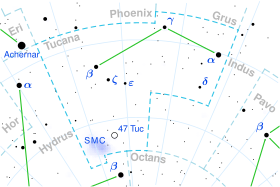
| |
| Observation data Epoch J2000 Equinox J2000 | |
|---|---|
| Constellation | Tucana |
| Right ascension | 23 17 25.77222 |
| Declination | −58° 14′ 08.6287″ |
| Apparent magnitude (V) | +3.99 |
| Characteristics | |
| Spectral type | F1 III or F3 IV/V or F4 V |
| U−B color index | -0.02 |
| B−V color index | +0.39 |
| Astrometry | |
| Radial velocity (Rv) | +18.4±0.7 km/s |
| Proper motion (μ) | RA: -35.83 mas/yr Dec.: +81.16 mas/yr |
| Parallax (π) | 43.37 ± 0.63 mas |
| Distance | 75 ± 1 ly (23.1 ± 0.3 pc) |
| Absolute magnitude (MV) | 2.18 |
| Details | |
| Mass | 1.55 M☉ |
| Radius | 2.2 R☉ |
| Luminosity | 11.33 L☉ |
| Surface gravity (log g) | 3.92 cgs |
| Temperature | 6,679 K |
| Metallicity | −0.22 dex |
| Rotational velocity (v sin i) | 94 km/s |
| Age | 1.414 Gyr |
| Other designations | |
| γ Tuc, CPD−58° 8062, FK5 877, GC 32413, GJ 9818, HD 219571, HIP 114996, HR 8848, SAO 247814, GSC 08837-01297 | |
| Database references | |
| SIMBAD | data |
Gamma Tucanae, Latinized from γ Tucanae, is a star in the constellation Tucana, marking the toucan's beak. It is faintly visible to the naked eye with an apparent visual magnitude of +3.99. Based upon an annual parallax shift of 43.37 mas as seen from Earth, this star is located about 75 light years from the Sun. It is moving away from the Sun with a radial velocity of +18 km/s.
There is disagreement in the literature as to the stellar classification of this star. Malaroda (1975) has it catalogued as F1 III, which would suggest it is an evolved F-type giant star. Houk (1979) listed it as F3 IV/V, which appears to indicate a less evolved F-type star transitioning between the main sequence and subgiant star. Gray et al. (2006) has it classed as F4 V, which would match an ordinary F-type main-sequence star.
This star is a suspected astrometric binary. The visible component has 1.55 times the mass of the Sun and 2.2 times the Sun's radius. At the age of around 1.4 billion years, it retains a relatively high rate of spin with a projected rotational velocity of 94 km/s. It is radiating 11 times the Sun's luminosity from its photosphere at an effective temperature of 6,679 K.
Gamma Tucanae may (95% chance) have a distant co-moving companion – a magnitude 6.64 G-type main-sequence star of class G0 V designated HD 223913. This object has the same mass as the Sun and is separated from Gamma Tucanae by about 11 ly (3.5 pc).
References
- ^ Van Leeuwen, F. (2007). "Validation of the new Hipparcos reduction". Astronomy and Astrophysics. 474 (2): 653–664. arXiv:0708.1752. Bibcode:2007A&A...474..653V. doi:10.1051/0004-6361:20078357. S2CID 18759600. Vizier catalog entry
- ^ Shaya, Ed J.; Olling, Rob P. (January 2011), "Very Wide Binaries and Other Comoving Stellar Companions: A Bayesian Analysis of the Hipparcos Catalogue", The Astrophysical Journal Supplement, 192 (1): 2, arXiv:1007.0425, Bibcode:2011ApJS..192....2S, doi:10.1088/0067-0049/192/1/2, S2CID 119226823
- ^ Malaroda, S. (August 1975), "Study of the F-type stars. I. MK spectral types", Astronomical Journal, 80: 637–641, Bibcode:1975AJ.....80..637M, doi:10.1086/111786.
- ^ Houk, Nancy (1979), Michigan catalogue of two-dimensional spectral types for the HD stars, vol. 1, Ann Arbor, Michigan: Department of Astronomy, University of Michigan, Bibcode:1978mcts.book.....H.
- ^ Gray, R. O.; et al. (July 2006), "Contributions to the Nearby Stars (NStars) Project: spectroscopy of stars earlier than M0 within 40 pc-The Southern Sample", The Astronomical Journal, 132 (1): 161–170, arXiv:astro-ph/0603770, Bibcode:2006AJ....132..161G, doi:10.1086/504637, S2CID 119476992.
- ^ Ducati, J. R. (2002). "VizieR Online Data Catalog: Catalogue of Stellar Photometry in Johnson's 11-color system". CDS/ADC Collection of Electronic Catalogues. 2237. Bibcode:2002yCat.2237....0D.
- ^ Gontcharov, G. A. (2006). "Pulkovo Compilation of Radial Velocities for 35 495 Hipparcos stars in a common system". Astronomy Letters. 32 (11): 759–771. arXiv:1606.08053. Bibcode:2006AstL...32..759G. doi:10.1134/S1063773706110065. S2CID 119231169.
- ^ Anderson, E.; Francis, Ch. (2012). "XHIP: An extended hipparcos compilation". Astronomy Letters. 38 (5): 331. arXiv:1108.4971. Bibcode:2012AstL...38..331A. doi:10.1134/S1063773712050015. S2CID 119257644. Vizier catalog entry
- ^ Allende Prieto, C.; Lambert, D. L. (1999). "Fundamental parameters of nearby stars from the comparison with evolutionary calculations: Masses, radii and effective temperatures". Astronomy and Astrophysics. 352: 555–562. arXiv:astro-ph/9911002. Bibcode:1999A&A...352..555A. Vizier catalog entry
- ^ David, Trevor J.; Hillenbrand, Lynne A. (2015). "The Ages of Early-Type Stars: Strömgren Photometric Methods Calibrated, Validated, Tested, and Applied to Hosts and Prospective Hosts of Directly Imaged Exoplanets". The Astrophysical Journal. 804 (2): 146. arXiv:1501.03154. Bibcode:2015ApJ...804..146D. doi:10.1088/0004-637X/804/2/146. S2CID 33401607. Vizier catalog entry
- ^ Hoffleit, D.; Warren, W. H. (1995). "VizieR Online Data Catalog: Bright Star Catalogue, 5th Revised Ed. (Hoffleit+, 1991)". VizieR On-line Data Catalog: V/50. Originally Published in: 1964BS....C......0H. 5050. Bibcode:1995yCat.5050....0H.
- "Gamma Tucanae". SIMBAD Astronomical Database. Centre de Données astronomiques de Strasbourg. Retrieved 20 October 2013.
- Knobel, E. B. (1917). "On Frederick de Houtman's Catalogue of Southern Stars, and the Origin of the Southern Constellations". Monthly Notices of the Royal Astronomical Society. 77 (5): 414–32 . Bibcode:1917MNRAS..77..414K. doi:10.1093/mnras/77.5.414.
- Eggleton, P. P.; Tokovinin, A. A. (September 2008), "A catalogue of multiplicity among bright stellar systems", Monthly Notices of the Royal Astronomical Society, 389 (2): 869–879, arXiv:0806.2878, Bibcode:2008MNRAS.389..869E, doi:10.1111/j.1365-2966.2008.13596.x, S2CID 14878976.
- Shaya, Ed J.; Olling, Rob P. (January 2011), "Very Wide Binaries and Other Comoving Stellar Companions: A Bayesian Analysis of the Hipparcos Catalogue", The Astrophysical Journal Supplement, 192 (1): 2, arXiv:1007.0425, Bibcode:2011ApJS..192....2S, doi:10.1088/0067-0049/192/1/2, S2CID 119226823
| Constellation of Tucana | |||||||||||
|---|---|---|---|---|---|---|---|---|---|---|---|
| Stars |
| ||||||||||
| |||||||||||
| Star clusters |
| ||||||||||
| |||||||||||
| Galaxies |
| ||||||||||